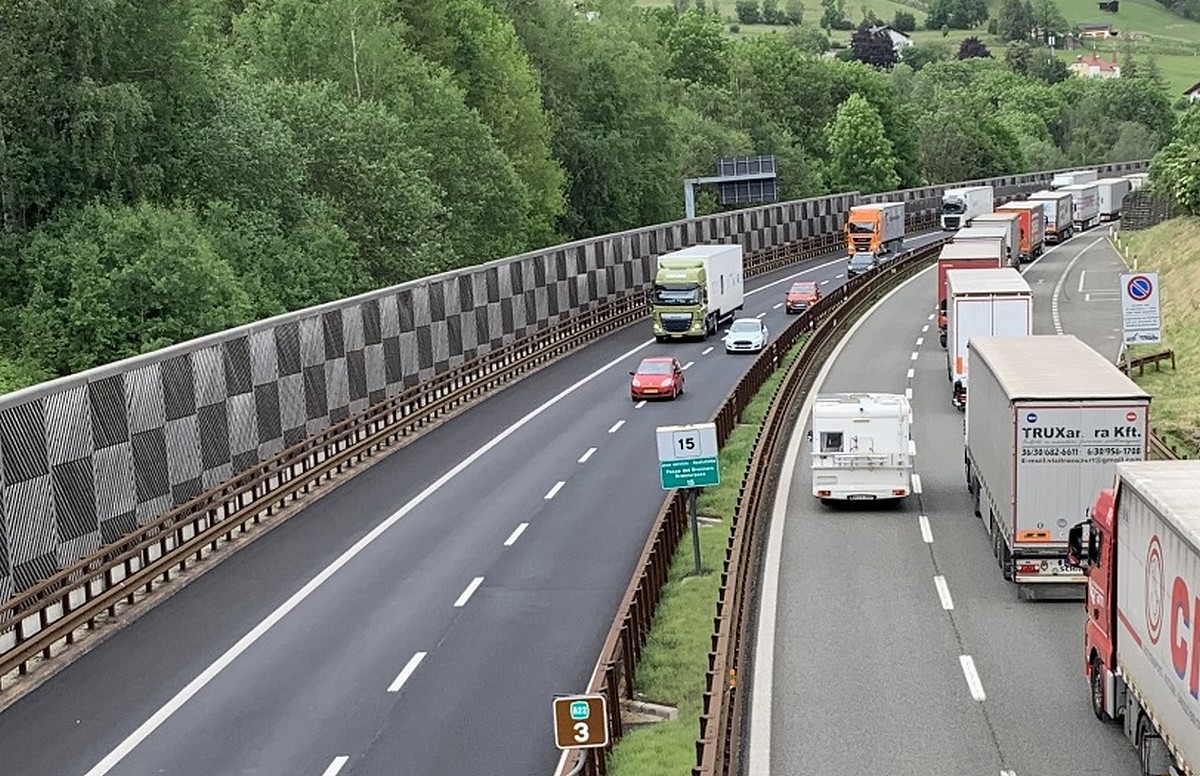Inspections of the Luegbrücke Bridge on the Austrian A13 have confirmed the need for action. To ensure the bridge remains safe for use, its superstructure must be relieved of some of its load.
“As a result, traffic on the bridge will be limited to one lane in each direction from 1 January 2025. This is the only way to ensure the bridge’s safe use going forward,” assured Asfinag, the Austrian motorway authority.
Tests of this traffic arrangement were conducted during the summer, and according to Asfinag, the system passed. It will be implemented from the start of 2025 and will remain in place for up to three years.
Extensive package of measures
Asfinag has prepared a broad range of measures aimed at preventing severe traffic congestion, particularly on busy days, while also protecting local communities from increased traffic on alternative routes.
A key element of this package is an innovative solution allowing temporary two-lane traffic on days with exceptionally high traffic volumes.
“To achieve this, vehicles over 3.5 tonnes must move to the left lane, i.e., to the centre of the bridge, to reduce pressure on the edges of the structure. This traffic arrangement will be applied flexibly on approximately 170 days a year, depending on traffic, either northbound or southbound. A permanent two-lane system would significantly reduce the lifespan of the bridge and is therefore not feasible,” explained Asfinag.
Specifically, dual carriageway traffic will be implemented on more than 170 days heading towards Brenner (south) and over 160 days heading towards Innsbruck (north). This flexible system, based on Asfinag’s traffic data, will significantly reduce congestion.
In addition, Asfinag will employ other solutions such as traffic control systems, additional truck bans, sectional speed monitoring, and new information boards. A Europe-wide information campaign will also be launched.
A detailed schedule for these measures is expected to be published in November.
Vehicle weighing in Nößlach and Brenner
Next year, vehicle weighing will play a key role in managing traffic on the A13.
“On the right-hand lanes, weighing devices installed in the roadway will monitor vehicle weights as they drive. If a vehicle weighing more than 3.5 tonnes mistakenly uses the right lane, the system will ensure it does not cross the bridge. Such vehicles will be diverted to the Nößlach parking area or at the Brenner-Nord junction, where they will be checked and then directed back to the correct left lane,” Asfinag reports.
These checks will be carried out by staff, as this is the only way to ensure that vehicles over 3.5 tonnes do not use the right lane.
Complete truck bans
“However, additional measures are necessary. There will be truck bans for 15 days,” announced Stefan Siegele, head of Asfinag, as quoted by the Austrian portal Kurier.at. These restrictions will be introduced mainly on weekends when traffic is particularly heavy, and even the emergency measures are insufficient to maintain smooth traffic flow.
“There is no alternative,” Siegele added when asked about potential protests or lawsuits from Italy and Germany. According to Siegele, without these additional driving bans, traffic jams stretching 10 to 20 kilometres could be expected.
Industry appeals unanswered
The decision to introduce additional truck bans on the Brenner motorway will likely face criticism from Italian and German hauliers, who have been calling for the lifting of night or sectoral traffic bans in connection with the planned works on the Lueg Bridge.
The motorway, which handles around 14.3 million cars and 2.5 million trucks annually, is part of the Trans-European Transport Network (TEN-T) and lies within the Scandinavia-Mediterranean corridor.
Earlier appeals by transport associations and politicians from Italy and Germany to temporarily ease restrictions on truck traffic have gone unanswered.
In July this year, European hauliers turned to Brussels. The German Federal Association for Goods Transport, Logistics and Utilisation (BGL), along with eight European trade associations and the International Road Transport Union (IRU), jointly called on the European Commission to take urgent action to ensure the free movement of goods on this crucial European route in the coming years. However, Brussels has yet to respond.
Impact on Italy’s competitiveness
Italy has already voiced concerns over the announced restrictions on Austria’s A13.
“We are seriously concerned about the measures announced by Asfinag. They will again allow Austria to restrict freight traffic from Italy to the Scan-Med corridor, a key pillar of the TEN-T network,” said Thomas Baumgartner, former president of the ANITA hauliers’ association.
“Moreover, the narrowing of lanes on the Italian side of the A22 motorway during maintenance works has shown that traffic remains smooth on weekdays and only becomes problematic on holidays when tourist traffic is present,” Baumgartner added.
The association is appealing to Italian Transport Minister Matteo Salvini to ensure fair treatment of the haulage sector, without discrimination or favouring tourist traffic or traffic arriving in or departing from Austria, which often enjoys preferential conditions for free movement.
According to Baumgartner, the cost of these restrictions will be borne by Italian manufacturers, who rely on road transport to remain competitive and boost exports, benefiting the Italian economy.
Roadworks start Monday
Meanwhile, Asfinag will begin urgent repairs on the Lueg Bridge starting next Monday (7 October).
“This will require a single-lane system for several weeks. As in previous years, the repairs have been scheduled for October when traffic is lighter. The work must be completed before winter,” the road manager explained.
Asfinag currently expects one lane to be in operation for three to four weeks, depending on weather conditions during this period.









